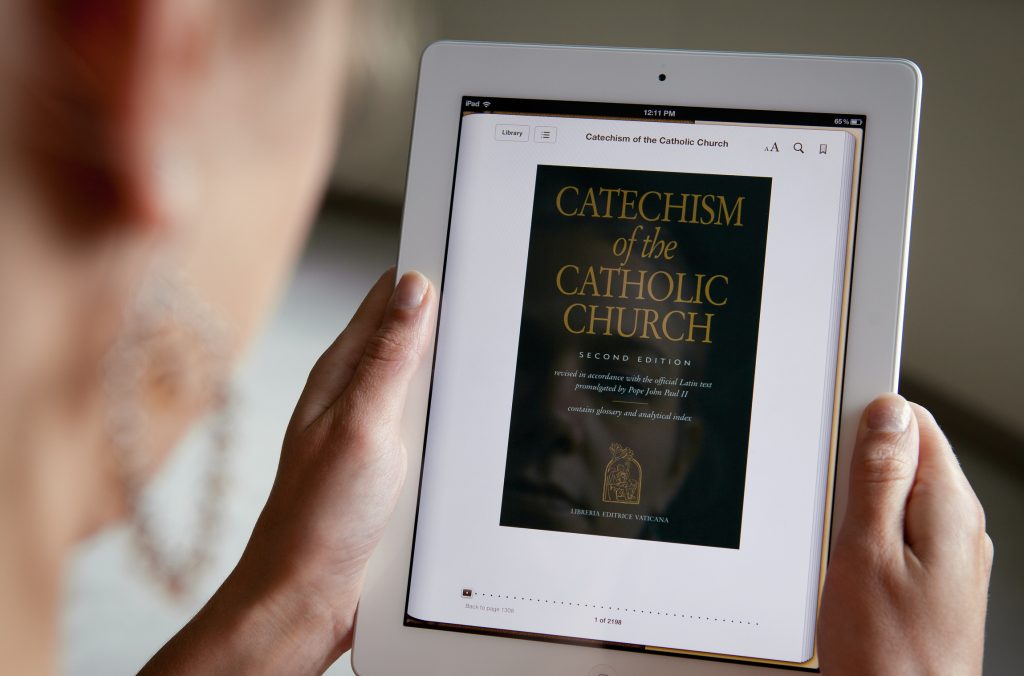Thirty years ago, on Oct. 11, 1992, the Catechism of the Catholic Church was published.
If the catechism is just a book on the shelf, take it down and open it up. You will be surprised.
The Church’s doctrines, teachings, all the norms of our faith, are presented clearly and with authority. But this is much more than a collection of rules.
In these pages, you hear the voices of the Church down through the ages — prophets, apostles, Church Fathers, saints, popes, and Church councils. You hear echoes from ancient prayers and liturgies.
The Church’s teachings are like a symphony, St. Pope John Paul II liked to say. Each teaching is essential to the whole, united in a single revelation from God about who he is, and who he created us to be.
What we believe is intended to lead us to follow and worship the One we believe in, and to make his teaching the way and the truth for our lives. At the heart of the catechism is Jesus Christ.
“It is Christ alone who teaches,” we read. “Anyone else teaches to the extent that he is Christ’s spokesman, enabling Christ to teach with his lips” (CCC 427).
These are words that should be prayed and reflected on every day by every teacher and catechist.
Every paragraph in the catechism is filled with citations and words from Scripture.
If you read this book with your Bible, looking up the context for these citations, if you follow the many cross-references found in almost every paragraph, the catechism becomes spiritual reading.
You are swept up in the mystery of salvation history: “From the liturgical poem of the first creation to the canticles of the heavenly Jerusalem, the inspired authors proclaim the plan of salvation as one vast divine blessing” (CCC 1079).
There are beautiful summaries of the meaning of our lives: “God put us in the world to know, to love and to serve him, and so to come to paradise” (CCC 1721).
Another: “The vocation of humanity is to show forth the image of God and to be transformed into the image of the Father’s only Son” (CCC 1877).
This is one of the most powerful sentences in the catechism. It is interesting that it begins a section on “the human community.”
The catechism reminds us that God’s plan, and the Church’s mission, are not only for the salvation of souls. The Gospel speaks to every aspect of human life, including the way we organize our economy and government.
The catechism’s sections on society’s purpose (CCC 1877–1948) and what makes for social justice (CCC 2419–2449) help us to understand that a deeper spiritual meaning underlies the events in our world.
The catechism is a rich source of wisdom and practical advice.
You can learn how to develop the habits of virtue, and get personal spiritual direction from a fourth-century saint, Gregory of Nyssa: “The goal of the virtuous life is to become like God” (CCC 1803).
There are “mission statements” and “marching orders” for moms and dads: “Parents have the first responsibility for the education of their children. They bear witness to this responsibility first by creating a home where tenderness, forgiveness, respect, fidelity, and disinterested service are the rule” (CCC 2223).
If you are a priest preparing a homily, you can gain insights on the Gospel by looking up how the text is used in the catechism. You’ll find references to almost every chapter and verse of the Gospels in the index.
And the catechism’s inspiring section on holy orders concludes with two beautiful quotes from saints that will remind you why you fell in love with Jesus and became a priest in the first place (CCC 1589).
The final section of the catechism is a masterpiece of spiritual writing about how to pray.
Read the section on the passage of the Lord’s prayer, “Give us this day our daily bread.” It should be a powerful inspiration in this time of the Eucharistic Revival (CCC 2828–2837).
And St. Justin Martyr’s long description of how the Mass was celebrated in the year A.D. 155 will help you understand why we call it “the Mass of all ages” (CCC 1345).
For me, the catechism is a great witness to our hope in Jesus Christ.
“Hope, O my soul, hope,” we hear from St. Teresa of Ávila. “The more you prove the love that you bear your God, the more you will rejoice one day with your Beloved, in a happiness that can never end” (CCC 1821).
Pray for me and I will pray for you.
And may our Blessed Mother Mary help all of us in the Church to remember that “the whole concern of doctrine and its teaching must be directed to the love that never ends” (CCC 25).

